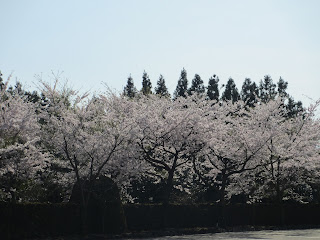“Where there are no
tigers, a wild cat is very self-important.” – Korean Proverb
I tried to do advance research on each place we are
visiting. However, I ran out of
time, and so never did much reading on South Korea. So, I’d have to figure it
out as we went along. All three stops turned out to be delightful surprises.

One of the things I hadn’t realized about Korea is how
pervasive are the cherry trees.
I
knew to expect them in Japan, but not here.
I’m used to the springtime cherry blossoms in DC, but they
are all concentrated in a particular area of the city.
In the places in Korea we visited, they
were everywhere—city and country—and we had the good fortune to be there when
they were at their peak, and when other blooms, such as forsythia, tulips, and
azaleas, were starting their springtime show.
First, we docked in Incheon, an industrial port city. However, I ignored Incheon and took the
90-minute bus ride into South Korea’s capital, Seoul. It’s a lovely, modern city with a pace that is brisk but not
intense. It just seemed like a very
liveable city.
South Korea’s National Museum is a stunning edifice in
Seoul, and maintains all manner of collections: natural history, human history,
art, etc. There was no way to see
the whole thing in a day, so with the help of our guide, we spent a couple of
hours viewing what have been designated as national treasures. In many ways,
the building that housed them was one such treasure, but the Buddhas, ancient
porcelain (I particularly loved the celadon), and historic artifacts were
fascinating.
We then proceeded to the television tower, to go to the
top for a view of the sprawling (and blooming) city.
This was followed by a delicious lunch of Korean
dishes.
I’d had the pleasure of
living above a good Korean restaurant in DC, but got a different take on those
familiar flavors here.
I was
particularly taken with the kimchi here, particularly the radish kimchi, which
had a more nuanced flavor that what I had known before.
Afterward, we took a walk through a neighborhood of older,
traditional homes in the heart of Seoul.
These modest homes sell for around the equivalent of $700,000, even
though the residents are plagued with sightseers—so much so that the homeowners
hang out signs imploring visitors to be quiet.
The weather was perfect that day, so the streets were filled
with other sightseers, both local and foreign.
The neighborhood also boasts a number of nice shops and
restaurants, so appears to be a favorite haunt for many.
Our next stop in South Korea was Jeju Island, a resort
island off the coast of Korea.
At
first it was perplexing as to why it is such a popular resort, as is it seemed
to be just another large-ish city and is prone to temperature extremes and just
about every kind of natural disaster known to humankind.
Then we got out into the countryside
and saw what beauty lies outside the city.
For densely populated countries like Korea and Japan, the
rural aura must be a true retreat. Plus, it is the one location in South Korea
where Chinese citizens can visit without a visa.
Finally, particularly as compared with some nearby
countries, prices are relatively low.
On Jeju, we enjoyed a stroll through a traditional
village. Only about 600 people
live here now, in the old-fashioned thatched huts and simple designs, and most
of the residents are getting up in age.
But the huts now have the modern conveniences, though a cluster are
preserved in their original form for tourism purposes.
Perhaps the most interesting in the original-form houses
were the “toilets” a seat made of
rocks that opens into a small pen, where they used to keep pigs. The idea was that the pigs ate the
waste, thus creating a natural means of disposing of human waste. But let’s not think about eating that
pork.
We also visited a volcano park, and took a pleasant stroll
around the crater’s rim (with the crater bearing an odd resemblance to Dorton
Arena at UNC) and explored the area, with breathtaking views at every
turn.
Our next stop in Korea was Busan (also, for
reasons unknown, called Pusan).
This was the pleasantest surprise of
all.
A city both modern and old-fashioned,
it had so many diverse elements it is hard to enumerate them all.
Its fish market is mind-boggling in its
size and offerings.
Stand after
stand of seafood in tanks, and people negotiating for their fish.
Outside were more stands, some still
selling fresh fish, others selling dried fish, and still others selling accompaniments.
In Busan, you could shop to your heart’s content in the
world’s largest department store, or in the many shops on or under the
street—there was an extensive network of underground shopping.
Catch the hop-on-hop-off bus, and see the center city, the
numerous parks, the beaches, and the daily life of a city with both skyscrapers
and lovely flora.
We saw a lot of tourists here, but very few westerners, so
were ourselves a bit of a curiosity to some. But children, their parents, school girls, and young women taking
selfies all seemed open, engaging and friendly. South Korea was truly a great place to visit. I only wish we’d had more time.
Next up:
Japan













